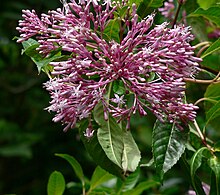Fuchsia paniculata
| Fuchsia paniculata | |
|---|---|

| |
| Scientific classification | |
| Kingdom: | Plantae |
| Clade: | Tracheophytes |
| Clade: | Angiosperms |
| Clade: | Eudicots |
| Clade: | Rosids |
| Order: | Myrtales |
| Family: | Onagraceae |
| Genus: | Fuchsia |
| Species: | F. paniculata
|
| Binomial name | |
| Fuchsia paniculata | |
Fuchsia paniculata is a plant of the genus Fuchsia native to Central America. It belongs to the section Schufia and is most closely related to Fuchsia arborescens.[1]
Description
Fuchsia paniculata is a tall shrub or small tree, typically reaching 3–8 metres (9.8–26.2 ft) in height. It usually has smooth, erect branches that are 1–4 centimetres (0.39–1.57 in) long and 2–5 centimetres (0.79–1.97 in) thick, with older branches and the main trunk measuring 2-15 cm thick.
The leaves are arranged oppositely or in whorls of 3-4, and are elliptic to oblanceolate in shape, with a pointed or narrowly wedge-shaped base and a pointed to tapering tip. They are 5–15.5 centimetres (2.0–6.1 in) long and 2–5.5 centimetres (0.79–2.17 in) wide, with a shiny dark green upper surface and a paler lower surface. The leaf margins are finely to coarsely serrated, and the leaf stalks are 0.8–2.6 centimetres (0.31–1.02 in) long. The stipules are triangular, often fused together, and 0.8-1.2 mm long and 0.7-1.5 mm wide, and they fall off after some time.
The flowers are numerous and upright, arranged in terminal clusters that branch dichotomously or trichotomously. The flower clusters are 10-14 cm long and 9-12 cm wide, tapering towards the tip. The perfect flowers have slender stalks that are 8-12 mm long. The floral tube is cylindrical to somewhat cone-shaped, 4-8 mm long at the base and 1-2 mm wide, widening to 1.5-3 mm at the rim. The sepals are lance-shaped, 5-10 mm long and 1.1-2.5 mm wide, and they spread outwards or bend back during flowering. The tube and sepals are pinkish-purple, while the petals are lavender and lance-shaped to elliptical, 4-10 mm long and 1.1-3.5 mm wide, with pointed ends. The nectary forms a smooth to irregularly lobed ring, 1.3-2 mm high, attached to the base of the tube. The filaments (stalks) of the stamens are 4-13 mm long for those opposite the sepals and 2-11 mm long for those opposite the petals, and they are pink. The anthers are broadly oval to kidney-shaped, 0.8-1.6(-2) mm long and 0.7-1.4 mm thick. The style is sparsely hairy, and it is either longer than the anthers with a short, 4-lobed stigma that protrudes beyond the anthers or it is shorter and the stigma is greatly reduced, both forms being lavender.
The pistillate flowers are similar to the perfect flowers but with some differences: the floral tube is smaller (3-5.5 mm long at the base and 0.7-1.7 mm wide, widening to 1.5-2.2 mm at the rim), the sepals are shorter (3.5-7 mm long and 0.7-1.3 mm wide), the petals are shorter (2.3-4.5 mm long and 0.6-1.3 mm wide), and the nectary is shorter (0.8-1.4 mm high). The filaments of the stamens are shorter (1.5-4.9 mm long for those opposite the sepals and 1.0-3.9 mm long for those opposite the petals), and the anthers are undeveloped (0.4-0.8 mm long and 0.2-0.6 mm thick). The style is stout, 7-11 mm long, with a well-exerted, 4-lobed stigma that is 0.6-1.9 mm long.
The fruit is nearly round, 4-9 mm long and 4-7 mm thick, with a bluish-purple color and a whitish, waxy coating. The seeds are 1-1.4 mm long and 0.5-0.8 mm thick.[2]
Subspecies
There are two recognized subspecies:[3]
| Image | Name | Description | Distribution |
|---|---|---|---|
| Fuchsia paniculata subsp. mixensis P.E.Berry & Breedlove | Plant 2.5-4 meters tall, branchlets are finely pubescent with 0.2-0.4 mm long hairs, larger leaves 11-25 x 4-10 cm pluberent on the lower surface along the veins.[4] | Mexico (Oaxaca) | |
 |
Fuchsia paniculata subsp. paniculata | Plant 3-8 meters tall, leaves 5-15.5 x 2-5.5 cm | Found in Mexico (Puebla, Veracruz, and Oaxaca), Costa Rica, El Salvador, Guatemala, Honduras |
References
- ^ Berry, Paul E.; William J. Hahn; Kenneth J. Sytsma; Jocelyn C. Hall; Austin Mast (2004). "Phylogenetic relationships and biogeography of Fuchsia (Onagraceae) based on noncoding nuclear and chloroplast DNA data". American Journal of Botany. 91 (4): 601–14. doi:10.3732/ajb.91.4.601. PMID 21653416.
- ^ "Onagraceae". Species Page/ Botany, National Museum of Natural History, Smithsonian Institution. Retrieved 2024-04-16.
- ^ "Plants of the World Online". Plants of the World Online. 2020-07-03. Retrieved 2024-04-16.
- ^ "Onagraceae". Species Page/ Botany, National Museum of Natural History, Smithsonian Institution. Retrieved 2024-04-16.
External links
 Media related to Fuchsia paniculata at Wikimedia Commons
Media related to Fuchsia paniculata at Wikimedia Commons Data related to Fuchsia paniculata at Wikispecies
Data related to Fuchsia paniculata at Wikispecies